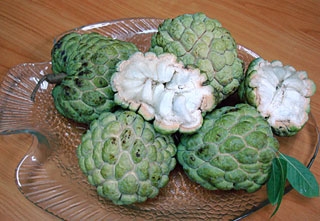Researchers from Spain and U.S. discover 'seedless' cherimoya gene
Thanks to researchers in the United States and Spain, it may not be long before you find yourself packing a cherimoya, rather than an apple or banana, in your kids’ lunchboxes.
The researchers recently combined their expertise in an effort to show how to develop a seedless version of the Cherimoya – which Mark Twain called "the most delicious fruit known to man."
The cherimoya, also known as the custard apple, and the closely related sugar apple and soursop, all are known for having big, awkward seeds. New seedless versions of these tasty fruits would undoubtedly be much more appealing to consumers.
"This could be the next banana — it would make it a lot more popular," said Charles Gasser, a professor of molecular and cellular biology at UC Davis.
He noted that, although all commercial banana varieties are seedless, bananas in their natural state have up to a hundred seeds.
The cherimoya project began in Spain, where researchers José Hormaza, Maria Herrero and graduate student Jorge Lora at the Consejo Superior de Investigaciones Cientificas labs in Malaga and Zaragoza, Spain, were studying the seedless variety of sugar apple. When they looked closely at the fruit, they noticed that the ovules, which would normally form seeds, lacked an outer coat.
They looked similar to the ovules of a mutant of the lab plant Arabidopsis that was discovered by Gasser's lab at UC Davis in the late 1990s. In Arabidopsis, the defective plants do not make seeds or fruit. But the mutant sugar apple produces full-sized fruit with white, soft flesh without the large, hard seeds.
The Spanish team contacted Gasser, and Lora came to UC Davis from Malaga to work on the project in Gasser's lab. He discovered that the same gene was responsible for uncoated ovules in both the Arabidopsis and sugar apple mutants.
"This is the first characterization of a gene for seedlessness in any crop plant," Gasser said.
Although there are seedless varieties of other commercial fruit crops in the grocery story, those are usually achieved by selective breeding. And – since the plants have no seeds – they are reproduced using plant cuttings or other methods of vegetative propagation.
Gasser is hopeful that discovery of this new gene could open the way to produce seedless varieties in sugar apple, cherimoya and perhaps other fruit crops.
In addition to its implication for commercial crops, the team’s research also sheds light on the evolution of flowering plants, Gasser said. Cherimoya and sugar apple belong to the magnolid family of plants, which branched off from the other flowering plants quite early in their evolution.
"It's a link all the way back to the beginning of the angiosperms," Gasser said, referring to the large group of plants and trees characterized by having flowers and seeds.
The researchers published a paper on describing their work in the March 14 issue of the scientific journal Proceedings of the National Academy of Sciences. Their research was funded by grants from the Spanish government, the European Union and the U.S. National Science Foundation.


Posted by Jamar Hussey on April 12, 2011 at 12:01 AM